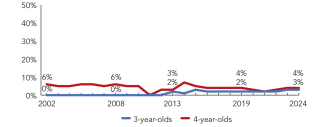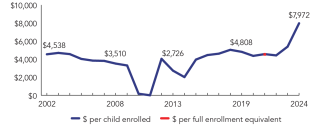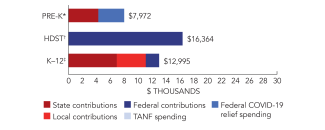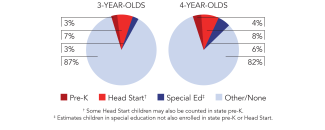
State of Preschool
Arizona
Access Rankings
Resource Rankings
Total Benchmarks Met
Overview

During the 2023-2024 school year, Arizona preschool enrolled 6,323 children, an increase of 369 from the prior year. State spending totaled $26,892,795 and an additional $23,511,685 in federal recovery funds supported the program, up $18,334,868 (57%), adjusted for inflation, since last year. State spending per child (including federal recovery funds) equaled $7,972 in 2023-2024, up $2,585 from 2022-2023, adjusted for inflation. Arizona met 3 of 10 quality standards benchmarks.
What's New

Federal COVID-19 relief funds were used to support Quality First (QF) Scholarships by increasing reimbursement rates to the cost of quality, increasing the eligibility threshold to 300% FPL, as well as increasing the number of scholarships available. First Things First Board approved the maintenance of the increased reimbursement rate for Quality First Scholarships. While the increase is positive, it will negatively impact enrollment in the 2024-2025 program year.
During 2023-2024, the Quality First (QIRS) model was revised so that quality improvement supports are more individualized to the needs of the participating programs. Lower rated programs receive more supports while higher rated programs receive fewer supports.
Background
Arizona began funding preschool programs in 1991 along with supplemental services for preschool, full-day kindergarten, and first through third grade education supported by the federal Early Childhood Block Grant (ECBG) from 1996 until 2010 when that funding ended.
In 2006, Arizona voters earmarked certain tobacco tax revenues for early childhood development and health programs and created the Early Childhood Development and Health Board, known as First Things First (FTF), to oversee those funds. FTF allocates funds to communities based on the birth to age 5 population and percentage of young children in poverty. Volunteer regional councils recommend early childhood strategies to fund, including QF Scholarships serving children birth to age 5 (before kindergarten) living at or below 300% FPL. Programs are eligible to receive QF Scholarships as long as they participate in QIRS and have met at least a three-star rating on the QIRS quality standards. QF Scholarship reimbursement rates vary by age of child (infants, toddlers, preschoolers).
Dramatic decreases in tobacco tax revenues have resulted in a $62.5 million drop as of SFY24 (37.9% less than the baseline year of 2008). Despite ongoing decreases in tobacco revenue, FTF’s commitment to QF Scholarships has grown, increasing from $35 million in FY16 to $46.2 million in FY23 in all settings (center-based and home based) and for all ages birth through 5 (before kindergarten). FTF collaborates with the state to meet federal match requirements and preserve about $47 million per year in federal Child Care and Development Fund (CCDF) funds. In the 13 years this partnership has been in place, Arizona has been able to leverage $511.7 million in federal subsidy dollars that otherwise would have been lost.
Quality First Scholarships
Access
Resources
| Total state pre-K spending | $50,404,480 |
| Local match required? | No |
| State Head Start spending | $0 |
| State spending per child enrolled | $7,972 |
| All reported spending per child enrolled* | $7,972 |

*Pre-K programs may receive additional funds from federal or local sources that are not included in this figure. †Head Start per-child spending includes funding only for 3- and 4-year-olds. ‡K–12 expenditures include capital spending as well as current operating expenditures.
Arizona Quality Standards Checklist
| Policy | Requirement | Benchmark | Meets Benchmark? |
|---|---|---|---|
For more information about the benchmarks, see the Executive Summary and the Roadmap to State pages. | 3benchmarks met | ||
| Early Learning & Development Standards Benchmark | Comprehensive, aligned, supported, culturally sensitive | Comprehensive, aligned, supported, culturally sensitive | |
| Curriculum Supports Benchmark | Approval process & supports | Approval process & supports | |
| Teacher Degree Benchmark | HSD | BA | |
| Teacher Specialized Training Benchmark | None | Specializing in pre-K | |
| Assistant Teacher Degree Benchmark | None | CDA or equivalent | |
| Staff Professional Development Benchmark | 18 hours/year | For teachers & assistants: At least 15 hours/year; individual PD plans; coaching | |
| Maximum Class Size Benchmark | 26 (3-year-olds); 30 (4-year-olds) | 20 or lower | |
| Staff to Child Ratio Benchmark | 1:13 (3-year-olds); 1:15 (4-year-olds) | 1:10 or better | |
| Screening & Referral Benchmark | Immunizations | Vision, hearing & health screenings; & referral | |
| Continuous Quality Improvement System Benchmark | Structured classroom observations; Data used for program improvement | Structured classroom observations; data used for program improvement | |
